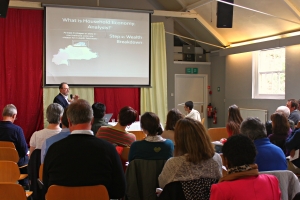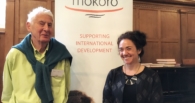Nutrition, Food Security & Livelihoods
A Mokoro Seminar
Zoe Driscoll
1 July 2014
/
- 0 Comments
With the significantly increased pressure on the global health and development community to meet its commitments on hunger and undernutrition, Mokoro’s recent seminar came as timely and topical. The seminar brought forward some leading research in nutrition, food security and livelihoods from three of our partners: NutritionWorks, Valid International and The Food Economy Group.
Paul Rees-Thomas from NutritionWorks began the morning with a nutrition focus. NutritionWorks has been working on a number of projects led by the DFID-funded Maximising the Quality of Scaling Up Nutrition Programmes Framework (MQSUN). The Scaling Up Nutrition (SUN) Movement was formalised in 2010 and exists to try and accelerate and enhance the scaling up of nutrition programmes globally, bringing a range of stakeholders (governments, civil society, UN, donors, and businesses) together. The Movement is focusing on the effective implementation of both specific actions for nutrition and nutrition-sensitive strategies – a dual approach to nutrition within their national development programme, making sure nutrition and other sectoral activities are aligned. The work conducted by MQSUN in conjunction with national movements currently involves costing, financial tracking and M&E, as well as situational analysis and planning development. NutritionWorks has worked on the review of 17 national nutrition policies from countries selected as priority by DFID and has supported the SUN Movement Secretariat on examining and classifying national costed plans. This is very much a bottom-up exercise, looking at country nutrition plans, and calculating the costs of what the countries themselves have put in the plans. Paul was able to highlight the progress in preparing for Scaling up nutrition, share the current MQSUN activities, and outline current challenges for MQSUN support.
Ernest Guevarra from Valid International introduced new survey techniques used to measure food security methods which are applicable across a variety of sectors. There have been improvements in measuring food security over time, but Ernest suggested that we rarely get a spatial dimension on food security. We are often presented with aggregate figures for food security indicators over a country, but this doesn’t necessarily give a representative figure of district-level food security. For most food security indicators, there is large spatial variation. It is important to consider at what scale results are given and whether these can be broken down to give accurate information at a smaller scale. For programmers, a higher spatial resolution of the data would be more beneficial to show variance. However, in predicting or monitoring food security, practitioners would want rapid results from an assessment, which brings methodological challenges. In order to look at changes over space and time, methods need to be accessible and less costly so that they can be carried out frequently. They need to be tools that can be picked up quickly. The methods implemented by Ernest and his Valid International Colleagues divide districts into quadrats and analysis is done at quadrat level for various food security indicators. These results have allowed practitioners to focus on hotspots of malnutrition and food insecurity and Ernest hopes that more and more the boundaries will be pushed to add the spatial dimension to surveys.
Neatly following this, Julius Holt presented The Food Economy Group’s work with Save the Children UK, using zonal surveys to analyse the way people obtain access to the things they need to survive and prosper. Over several years, The Food Economy Group and Save the Children UK have been developing the Household Economy Approach (HEA) Framework, dividing geographic areas of a country into livelihood zones in which people share broadly the same options for obtaining food and cash income and the same market opportunities and constraints. Within a livelihood zone, eight villages are selected for fieldwork and each zone is further divided into wealth groups. Finally datasets are developed for each wealth group detailing the relative contribution of different sources of food and cash income to the household economy, and balancing this against annual expenditure requirements. The HEA data can be used for various purposes, including as the context for ongoing early warning monitoring systems, development planning, monitoring and evaluation systems, and disaster risk reduction assessments. This data set has grown over the last 20 years and by using the same approach it has allowed for comparisons to be made within and across countries. The evidence has recently been used to present a consolidated picture through a series of reports called ‘Livelihoods at the Limit’. The first, ‘Reducing the risk of disasters and adapting to climate change’, answers some of the most pressing questions about disaster risk reduction and climate change adaptation in a range of livelihood contexts. The second, ‘Food Security in a Changing World’, provides empirical evidence to address four key policy and operational questions related to food security. Julius highlighted some of the emerging patterns that came out of these reports, which can be seen in detail in his presentation.
Mokoro are grateful to all speakers for their engaging presentations and also to our Principal Consultant, Catherine Dom, who chaired the event and was able to bring her in-depth country experience on Ethiopia to it. All presentations are available to download on our website.
You must be logged in to post a comment.



